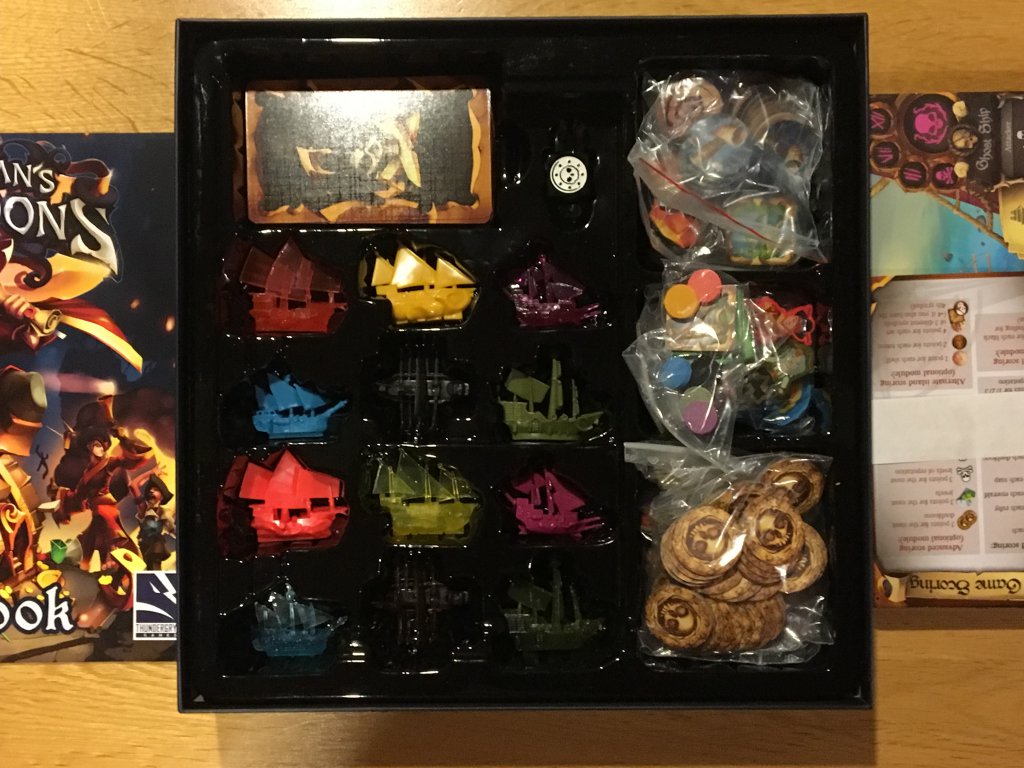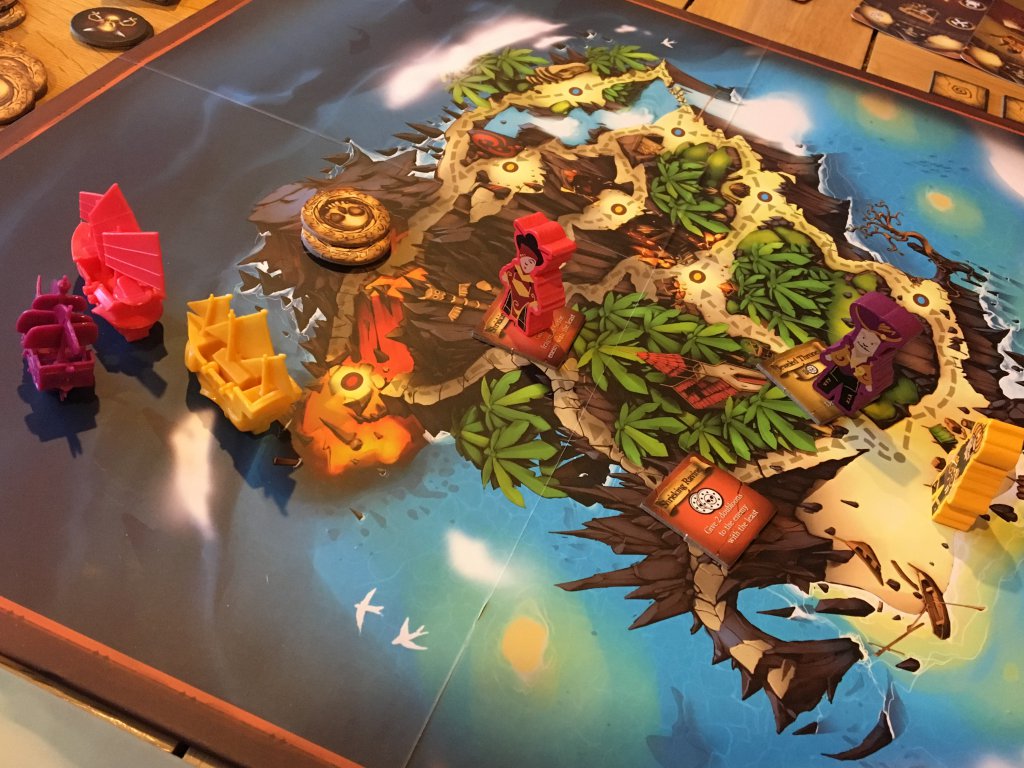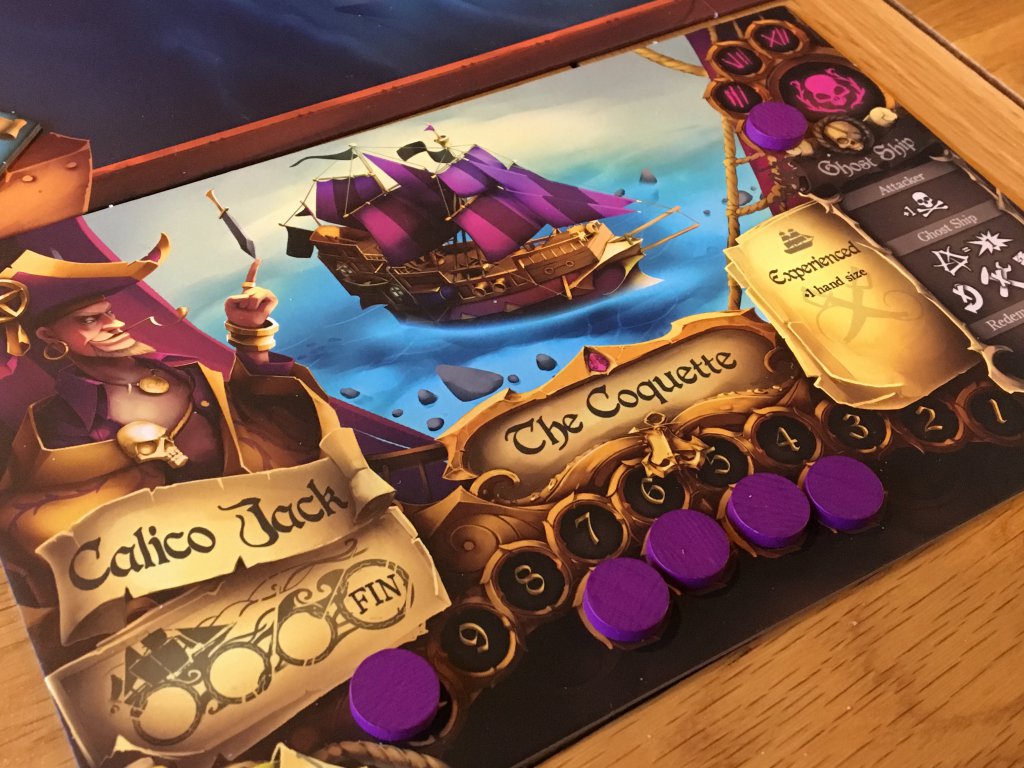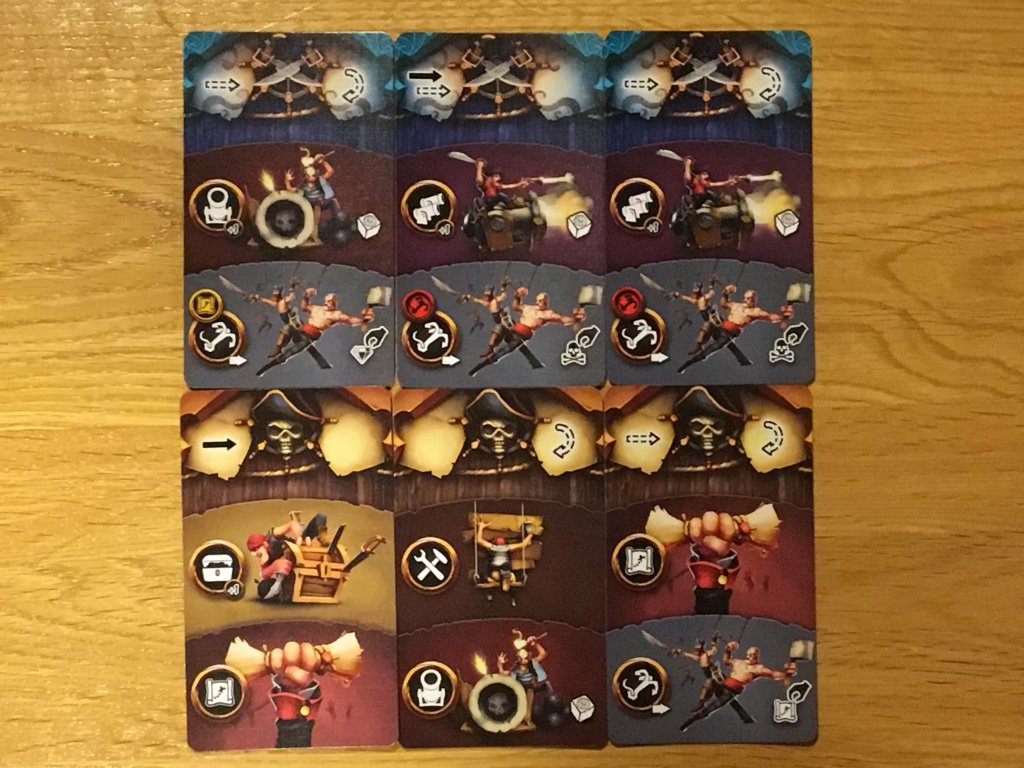Dead Mans Doubloons review — Salty dog
![Dead Mans Doubloons]()
- In Dead Mans Doubloons, two to six players take on the role of pirates seeking a lost treasure. Their crews circle a central island in a state of perpetual battle, all whilst the wacky pirate leaders compete to scale a deadly volcano atop which riches await. Once the treasure is found, the captains return to their ships and an endgame sequence is triggered to see which of them escapes from the battle with the most booty. A wide variety of alternative options (including bundled expansions, adjusted rules and even a double sided board) ensure that the experience is never the same twice.
Overview
Dead Mans Doubloons fits in the space that I’d be inclined to describe as a heavy party game. I say that simply because it’s much better with more players than it is at, say, three, yet it takes a minimum of about an hour or more to play, making the publisher’s stated forty five minutes seem very optimistic — at least in my experience. Setu p takes a while at first, mainly because there are so many additional modules and set up steps that it takes a bit of time to come to terms with. The basic, vanilla setup is the most straightforward, but even so, the players are still required to separate two decks of command cards, organise and build a deck of map tiles based on player count as well as sort a number of other token stacks.
With that done, each player will pick a named pirate captain and take their player board, pirate ships and tokens of the same colour, then set that little lot up (which is brief). Hands of command cards will then be drawn and the game can begin. Turns are pre-programmed in Dead Mans Doubloons (which I’ll explain later) so there is an element of predicting what opponents are doing, as well as enacting your own plans. Thankfully, each command card offers at least two options (and later, at least three) so it’s always possible to adapt.
Dead Mans Doubloons is filled with what is commonly referred to as “take that” gameplay, which simply means that you’ll often attack the other players directly and/or influence them in negative ways. Ships can be destroyed in the game, forcing them to return as ghost ships, which can be undone in return for five gold (which is not insignificant). It’s also possible to kill opposing crew members, which applies negative penalties to that player, or allows the attacking player to steal map tiles or loot
Most command cards allow (or force) the active player to move their ship in addition to taking one of the two actions. Whilst those actions may relate to either the ships or the captains on the island. When a captain action (explore) is taken, the active captain must move to an adjacent space on the island and draw an appropriate tile, which is then resolved. The blue path is long but relatively safe, whilst the yellow one is balanced. The red one, on the other hand, is very fast, but incredibly hazardous.
Components
Dead Mans Doubloons is a beautiful, beautiful game that has been produced to an incredible standard. The double-sized board is gorgeous and really thematic, whilst the ships are all very unique and extremely durable. Every captain has both their basic ship and a translucent ghost ship, which is really only there for aesthetics — there is no possible scenario where both ships will be in play at the same time. Each of the captain meeples is made from wood and printed with a cute little caricature of the image shown on the player board, which is a lovely and unusual feature.
The cards used to drive the action are larger than usual (probably about tarot card sized) and covered in lovely, cartoon artwork that depict swarthy pirate crews doing piratical things. After that there’s still a ton more in the box that I won’t go through in detail, but needless to say, it’s all of very high quality. There are large gold doubloons, tons and tons of tokens, lots of wooden chits to measure crew or other statuses and a lot more that I’ve probably forgotten. The inclusion of several Kickstarter expansions in a retail copy is really nice and several of these come with new components that you’ll want to keep bagged up separately for ease of set up.
Turn Structure
At the beginning of each round, the players all simultaneously choose three of their command cards (they may only have three, if their crew is all dead) which they will then place face down in front of them in the order they wish to play them. All cards are revealed at the same time, then resolved one by one beginning with the player holding the first player cutlass. A command card might indicate that the player must turn their ship about, then move, then choose to either shoot ahead one space or explore the island.
The board (in the base game at least) only features four spaces (one for each corner of the map) so combat will take place on almost every turn. In the example above where the command is to shoot forward one space, the player will look to the space ahead after their own movement, then shoot at (and automatically hit) all ships in that space. There are occasionally rules that affect this, for example when setting up the game, a blue tile is placed onto each corner of the board that will affect that space with further range or forced movement.
Whenever a captain takes an explore action, she will move along the mountain path towards the summit, but the real challenge will be in the form of whatever tile is uncovered as a result. This will sometimes be good (for example draw a gem token, which is worth points) or sometimes bad (for example kill two crew members) but in either case, all are quick to resolve. The game features a follow mechanic here that allows any pirate who has the same map token as the one you’ve just used to explore to follow one space up the path as well, which uses exactly the same rules for resolving unexplored spaces, or forces them to resolve a previously explored space again.
Finally, once the summit is reached, and a number of gems have been handed out depending on where each captain finished on the path, then the endgame is triggered. At this point, all captains return to their ships (increasing the crew count) and their meeples are placed on a countdown. A new set of more powerful (three action) captain command cards are shuffled into the main deck, then play continues just as it did before. The difference is that now, each time a player uses a captain’s command card, they’ll advance their captain meeple one space. Once the end of the track is reached, the game ends that round.
Game Experience
Whether or not you’ll enjoy Dead Mans Doubloons depends entirely on one thing – how much you do or don’t enjoy playing games that feature direct confrontation. Shooting at, looting from and ultimately sinking your friends ships is more or less the whole game in Dead Mans Doubloons and overall, I found that part of the game very fun. The programming mechanic is simple and fun and the way that the board is seeded differently for different player counts really forces continuous action with absolutely no let up.
A lot of games feature piratical themes, but few capture the slightly chaotic, extremely cutthroat nature that we see in movies like Pirates of the Caribbean. The gameplay is supported by excellent characterisation among the captains and ships and each has its own special ability that further enhances their uniqueness. Again, the components (the ships, the player boards and the captain meeples) really enhance this theme, over and above the already fantastic presentation that is simply the result of high quality pieces.
I found that Dead Mans Doubloons really came to life with four or five players, whilst with three, it felt too hard to single one player out, which is bad given the direct nature of the game. At five players, the game was great fun, but it took almost two hours and was very, very chaotic, with almost everyone ending as a ghost ship. That’s not overtly a bad thing — chaos can be a lot of fun and I certainly enjoyed that game — but, because Dead Mans Doubloons is quite imprecise at a basic level, that is only amplified by more players, and that might not appeal to everyone.
Conclusion
Whether or not you want to add Dead Mans Doubloons to your collection will depend on whether or not it sounds appealing to you when the ‘take that’, chaos and other factors are taken into account. It’s a light game by the standards of euro or worker placement games that might appeal to heavier game fans, but it’s also quite complex and rule heavy for an outright party game. That said, it does strike a balance between these two spaces that I quite enjoyed, speaking as someone who doesn’t especially get along with traditional party games.
The fantastic components really enhance the table appeal that Dead Mans Doubloons creates and, as such, it’s never hard to generate interest in kicking off a game in a communal atmosphere. As such, there’s little risk in adding the game to your collection if that’s the kind of environment you play in. The pirate theme also adds an element of excitement because it is so well executed, whilst at the same time it adds additional appeal for quite a broad range of audiences, including children, for example.
On the downside, it has a somewhat underwhelming endgame that I just don’t understand. The introduction of captain command cards and the whole countdown tracker feels arbitrary and weird, without actually changing the game much. What’s the thematic tie here? Why don’t the captain commands do more interesting things, or even form their own deck? I feel like there’s a missed opportunity here that could have been a bit more climactic – the volcano erupting and everyone desperately escaping, for example. That said, it’s a minor complaint on an otherwise excellent record and it shouldn’t be the factor that dissuades you.
A copy of Dead Mans Doubloons was provided for review purposes, and can be purchased from all good local games stores. For online purchases, please visit 365 Games.





Comments are closed.